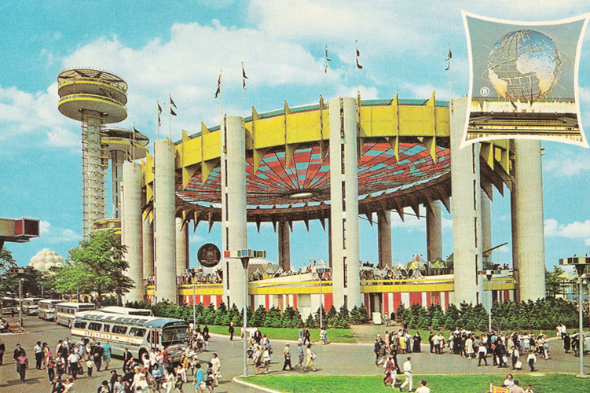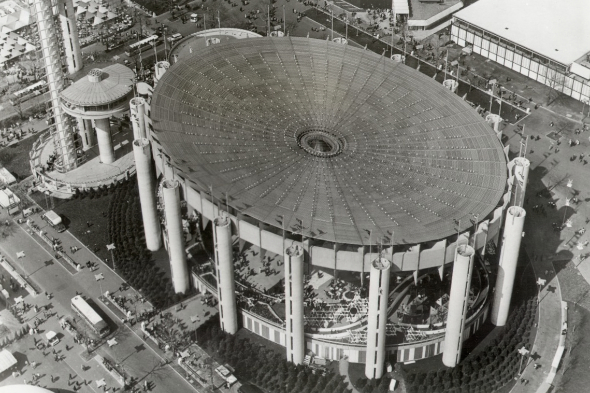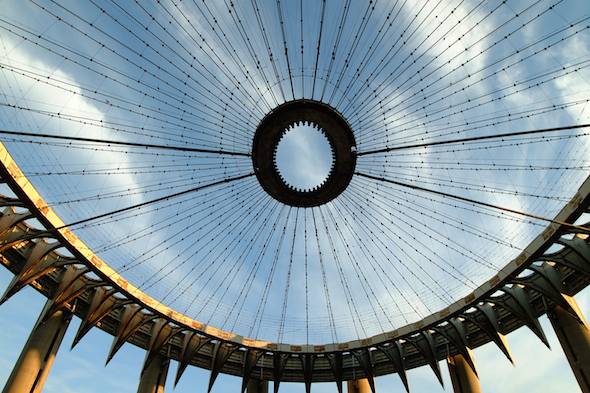The New York State Pavilion built for the 1964–65 World’s Fair with its colourful tent-like roof and observation towers was a prominent attraction during the fair. One of the memorable features of the Pavilion was a giant map of New York State inlaid in the terrazzo floor. After the World's Fair the Pavilion fell into disuse and disrepair.
When the World's Fair closed in 1965, nearly all the pavilions and other attractions were removed or demolished. The sponsors of the New York State pavilion handed it as a gift to New York City, probably to avoid the cost of demolition, possibily with the left-overs of the dreams which had been promoted by the fair's entrepreneurs, who by this time had to come to terms with huge debts. This is how the pavilion came under the authority of the New York City Parks Department. In the years following the fair, the pavilion was used for various activities, more or less informally. It was the venue for rock concerts well-remembered by some and it was a roller-skating rink for a time. Gradually the site became dilapidated and unsafe. It has been closed to the public for many years. The architect of the pavilion, Philip Johnson, was reportedly delighted that his ‘Tent of Tomorrow’ had achieved the status, apparently much prized by architects, of a ruin. There is a community of enthusiasts of the World's Fair dismayed by the current condition of the site, who would love to see it restored and acknowledged as a landmark and for its place in the history of the city. Their affection for the site might be shared by many New Yorkers.
NYC Parks & Recreation kindly provided the following statement about the current status of the site [in 2007]:
Parks & Recreation is currently seeking contributions to maintain the overall physical condition of the New York State Pavilion and is eager to discuss viable uses for this important survivor of the 1964 World’s Fair. Efforts to conserve the terrazzo Texaco map are already underway in collaboration with the University of Pennsylvania. Over the last two years, all of the debris has been cleared from the Pavilion floor. [In 2006] University of Pennsylvania graduate students restored two of the panels as a pilot project, which resulted in an NEA grant, as well as funding from Parks, for a total of $110,000. Parks and UPenn have worked closely to carefully remove vegetation and have been gathering loose pieces of terrazzo and plastic from the panels for preservation. [In 2007 UPenn planned to] remove 33 of the 4' x 4' panels and fully restore five. This work [was displayed] in an exhibition on the Pavilion and the Texaco map at the Queens Museum of Art [Jan 27–May 4 2008]. It is hoped that this project will act as a catalyst for future projects and allow us to gain greater attention and support for the Pavilion as a whole, as well as funding to conserve the remaining panels. As part of the restoration, the floor will also be stabilized for future protection and UPenn will document the entire map using the geographic information system (GIS).
Anthony Auerbach's aerial survey is the only comprehensive documentation of the terrazzo map from before the conservation project began. The conservators removed all the vegetation and loose material before making a record of their status quo ante. The panels removed by the conservators cannot be reinstalled in their original place. The proposed ‘stabilisation’ of the rest of the terrazzo by burying it under a layer of sand was not carried out. The vegetation is doing well again [2009].
Images
Postcard from the World's Fair (alamedainfo)
Aerial photograph, 1964 (nywf64)
Interior in 1965 (James P. Blair, National Geographic
Society modernmechanix)
Interior of the pavillion in 2006 (Anthony Auerbach)



